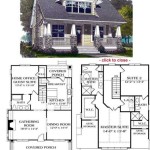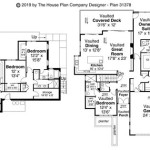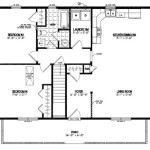Ground Floor Plan With Dimensions In Meters: A Comprehensive Guide
A well-designed ground floor plan is crucial for any residential or commercial building. It determines the layout, flow, and overall functionality of the space. Accurately dimensioning the plan is essential for ensuring that the construction process runs smoothly and that the finished building meets the desired specifications.
Why Are Dimensions Important?
Accurate dimensions on a ground floor plan serve several key purposes:
*Accurate Construction:
Dimensions provide precise measurements for builders to follow, ensuring that the structure is constructed according to the architect's design. *Compliance with Building Codes:
Dimensions help ensure that the building meets all applicable building codes and regulations, which often include specific requirements for room sizes, ceiling heights, and accessibility features. *Furniture Placement and Space Planning:
Accurate dimensions allow interior designers and homeowners to plan furniture placement and allocate space effectively, maximizing space utilization and creating comfortable living environments.Essential Elements of a Ground Floor Plan with Dimensions
A comprehensive ground floor plan with dimensions in meters typically includes the following elements:
*Property Boundaries:
The outline of the property, including setbacks and property lines. *Exterior Walls and Windows:
The location and size of exterior walls, windows, and doors, including dimensions for height and width. *Interior Rooms:
The layout and dimensions of all interior rooms, including living areas, bedrooms, bathrooms, and kitchens. *Circulation Spaces:
Dimensions for hallways, stairs, and other areas used for movement throughout the building. *Service Areas:
The location and dimensions of service areas such as laundry rooms, pantries, and utility closets. *Exterior Features:
Dimensions for patios, decks, driveways, and other exterior features. *Scale:
The scale of the drawing, indicating the ratio between the actual dimensions and the dimensions on the plan.Benefits of Dimensioning in Meters
Using meters for dimensions provides several advantages:
*International Standard:
Meters are the internationally recognized unit of length, making it easy to exchange plans and collaborate with contractors and engineers from different countries. *Accuracy:
Meters provide precise measurements, reducing the risk of errors and ensuring that the building is constructed to the intended specifications. *Consistency:
Using a single unit of measurement ensures consistency throughout the design and construction process, eliminating confusion and potential mistakes.Tips for Dimensioning Ground Floor Plans
* Use a scale that provides clear and readable dimensions. * Label all dimensions clearly and consistently. * Include dimensions for all relevant features, including walls, windows, doors, and circulation spaces. * Consider using a digital drawing tool to ensure precision and accuracy. * Have the dimensions reviewed by a qualified architect or engineer to ensure compliance with building codes and regulations.
Small House Plan 7x6 Meters 1 Bed Hip Roof Ground Floor Plans Design

A Floorplan Of Single Family House All Dimensions In Meters Scientific Diagram

12 Examples Of Floor Plans With Dimensions

40x40 House Plans 12x12 Meters 2 Beds Floor Samhouseplans

7x17 Meter House Ground Floor And First Plan Autocad Drawing Dwg File Cadbull

Ground Floor Plans For The Domestic Building Built Area Is 381 M 2 Scientific Diagram

Pin On House Plans

Rodolfo Four To Five Bedroom Modern House Plan Mhd 2024040 Pinoy Eplans

Small House Plans 5x7 Meters 2 Bedrooms Samhouseplans

1bhk Ground Floor Plan West Facing Single Bedroom House And Designs Books
Related Posts








